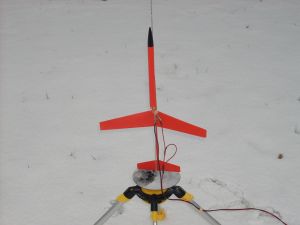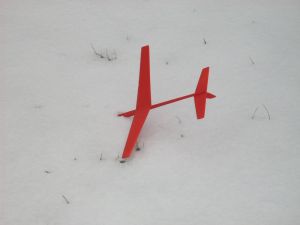| Construction Rating: | starstarstarstarstar_border |
| Flight Rating: | starstarstarstarstar |
| Overall Rating: | starstarstarstarstar |
| Diameter: | 0.79 inches |
| Length: | 20.00 inches |
| Manufacturer: | Quest  |
| Skill Level: | 3 |
| Style: | Glider |

Brief:
Low power rocket booster with streamer recovery and glider flight recovery.
Construction:
Rocket booster is basically an 18mm minimum diameter rocket with a balsa "hook" assembly on it instead of
fins. Glider is comprised completely of balsa. Wings and stabilizer are 1/8", fuselage is 1/4" x 1/2".
The instructions were good, except that there were a few places where the pictures really didn't match what you needed to do--I was glad that there was a detailed picture of the "hook" on the product packaging. I would say that Quest labeling this a skill model 3 kit is accurate. Most kits go up in skill level because of intricate paint jobs, however, this kit required real modeling skills.
The balsa in the kit was not consistent. One wing was nice, tight, strong grained balsa and the other one was made of weak, stringy balsa. The fuselage was a nice piece of wood. I had to really trace the parts with my X-Acto knife to get them out of the balsa stock since they were not punched all the way through.
The instructions on trimming the glider were good, but when it came to trimming the booster/glider assembly, it took me a while to figure it out.
I built mine as a true "flat cat," only dressing the leading and trailing edges of the wings and stabilizer. I did also massage out the fuselage per the instructions. The glider flew perfectly with no trimming.
Finishing:
Finishing was nothing special. I gave mine a quick sanding with 220 grit sandpaper and shot it with 2 coats of Krylon
spray paint. I figured that this would help seal the balsa and increase visibility. I did not put the stickers on mine.
Construction Rating: 4 out of 5
Flight:
After reading the other comments about this glider on EMRR, I decided to fly mine on an A8-3 for the first flight.
The field I use is kind of small, so I wasn't going for any altitude. I also added some clay weight to induce a spiral
in hopes of getting the glider back.
The rocket went about 200 feet and separation from the glider was perfect. The booster came down under streamer and landed about 15 feet from the pad. I must have added too much weight, because the glider didn't spiral, it corkscrewed down. It hit nose first in the snow and kinda rolled. No significant damage! The nose was a little flattened out though so I sanded it round again in the field.
 Second flight, I took a little bit of the clay weight off. Lift and separation were
identical, the booster dropping 30 feet from the pad. The glider did several nice spirals and stuck its nose into the
ground softly about 100 feet from the pad. I did not have a watch, but I would guess the glide to be around 10 seconds
or so.
Second flight, I took a little bit of the clay weight off. Lift and separation were
identical, the booster dropping 30 feet from the pad. The glider did several nice spirals and stuck its nose into the
ground softly about 100 feet from the pad. I did not have a watch, but I would guess the glide to be around 10 seconds
or so.
I didn't have an opportunity to fly it a third time. I was out of A8-3s and with the wind picking up, I didn't want more altitude.
Recovery:
Recovery of the booster is fine with the streamer. Recovery of the glider is a Catch-22. If you want it back, you
will have short glide times! It is all in the trimming, and the bigger the field the better. I would really like to
play with this on a big field!
Flight Rating: 5 out of 5
Summary:
This was a great kit and really delivers on its promises! This was the first boost glider that I have built, and it
has left me with a new respect for them. I can see the science behind it and how you could detail yourself to death
with a glider if you were trying to go for maximum glide time. Recovery is the killer on this though.
I actually had a lot of fun building this kit, especially learning how trimming it affects the glide recovery. Honestly, I probably won't ever launch this again, but will hand toss it a bunch! It is a great glider!
Overall Rating: 5 out of 5
Other Reviews
- Quest Flat Cat By Jim Bassham and Edie Parkhouse (June 28, 2010)
Brief: The Flat Cat is a classic boost glider with a streamer-recovery pod. Construction: Parts List: Launch lug 18mm motor tube 8.5 inch body tube Thrust Ring Plastic nose cone and base 24inch streamer and gripper tab Balsa fuselage Balsa pylon Three sheets of die-cut parts Motor mount Trim clay Elastic shock cord Kevlar ® ...
- Quest Flat Cat By Hank Helmen (November 13, 2008)
Brief: This is a boost glider rocket with streamer recovery for the booster. Construction: The Quest Flat Cat boost glider includes an 18mm body tube for the booster as well as an engine mount kit. There are die cut balsa wings and fins. Also included in the kit is a 24" plastic recovery streamer, shock cord, plastic nose cone and decals. The instructions were easy to ...
- Quest Flat Cat By Chris Taylor Jr. (November 5, 2008)
Packaging: Plastic bag with cardboard display picture. The Parts: Lots of very nice, high-quality, thick balsa wood. No skimpy stuff here. This is going to be one tough glider! Standard Pop-pod Glider. Basically a short, finless rocket that attaches the nose of the glider with a one-way hook, I. e. go up and it hooks, go back and it falls off. The motor's ejection ...
- Quest Flat Cat By Matt Gillard (December 30, 2007)
Brief: A pop pod glider for B and C motors. The design is tried and tested and there are two levels of finish: one simple one that is a quick glue together without any airfoils, which is where the flat part of its name comes from, and a second where there is a great deal of sanding involved. Quest puts this rocket at a skill level three which is about right for the airfoil version ...
 |
 |
Flights
 |
 |
R.J. (September 1, 2000)
B.M. (October 1, 2000)
(December 1, 2000)
HWH (November 9, 2008)
 |
 |
B.M. (August 1, 2000)